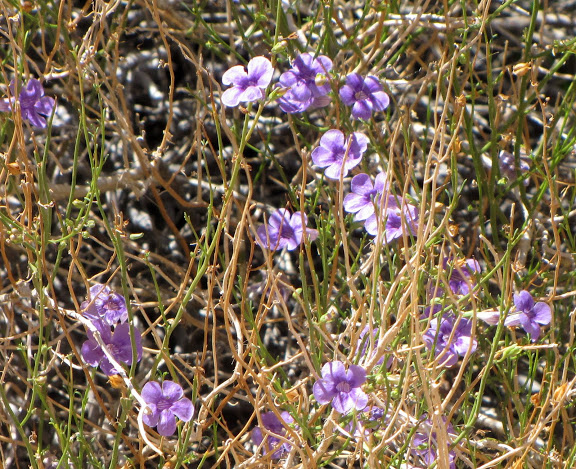Order: Lamiales. Family: Scrophulariaceae
 © Lisbeth
© LisbethAugrabies Falls National Park
Aptosimum spp are woody herbs or subshrubs. Leaves alternate, 1-veined, entire. Flowers axillary, solitary or in short cymes. Calyx 5-lobed; tube campanulate. Corolla 5-lobed; lobes rounded. Stamens 4.
There are 20 species in South Africa, all with similar flowers. They are difficult to distinguish and best told by leaves.
Description of the genus
Perennial undershrubs but sometimes flowering in herbaceous state, low, with or without elongated and often procumbent branches, sometimes cushion-forming or tufted, mostly woody at base. Leaves alternate, usually densely crowded on long or short shoots, linear, lanceolate, elongated or spathulate, entire, 1-nerved, midrib sometimes persistent and spinescent. Flowers solitary in leaf axils or in short axillary cymes, sessile or subsessile, bibracteolate, dark blue to violet. Calyx tubular, 5-lobed to various depths; tube campanulate; lobes linear to deltoid or ovate, +/- valvate in bud. Corolla tubular, slightly irregular, 5-lobed; tube elongated, much longer than calyx, widening suddenly above short, narrow base into a long throat, mouth wide; limb patent, much shorter than tube, oblique; lobes free, rounded, +/- equal, 2 posterior outside in bud. Stamens 4, didynamous, included, arising in lower part of corolla tube; filaments filiform; anthers of shorter, posterior pair smaller than those of longer, anterior pair and sometimes sterile, anthers bithecate, transverse, ciliate-hispid; thecae confluent so dehiscing along a single transverse line. Nectary usually saucer-shaped. Ovary bilocular; ovules many; style filiform, exceeding stamens; stigma small, obscurely bidentate, emarginate or subcapitate. Fruit a thick-walled capsule, obovoid, +/- globose, broadly ovoid or ovoid, upper part compressed at right angles to septum, emarginate, septicidal but opening only at top, often persistent; valves usually bifid. Seeds many, obovoid or flattened-globose; testa adpressedly reticulate.
Description
Aptosimum marlothii is a small woody shrub, 50 cm tall, thin, long and spiny branches with narrow leaves arranged in clusters, the tubular, blue to purple flower is larger than the leaves, fruit is a dark capsule.
Distribution
Namibia, South Africa (Free State, Northern Cape, North West).


